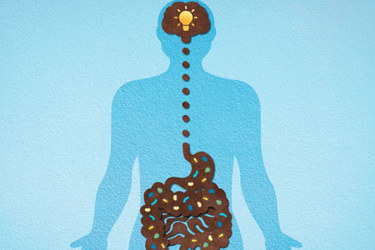Targeting The Gut–Brain Axis With Live Biotherapeutic Products

By Tyler Menichiello, Chief Editor, Bioprocess Online

Although the term itself is relatively new, humans have always had an innate understanding of the gut–brain axis. Only recently, however, has a clinical understanding emerged of how the microbes in our intestines contribute to and affect our brain function. The idea of targeting the microbiome and using bacteria as a way to treat neurological diseases is quickly gaining traction and clinical validation.
The FDA classifies these bacterial drugs as live biotherapeutic products (LBP). To learn more about this exploding field of LBPs — specifically, those aimed at leveraging the gut–brain axis — I met with Dr. Christopher Reyes, CEO of Bloom Science. Bloom’s lead drug candidate, BL-001, is a clinical-stage LBP aimed at treating Dravet syndrome and amyotrophic lateral sclerosis (ALS).
Why Target The Gut–Brain Axis?

“When we think about the interactions between the gut and the brain, there are multiple points of interaction,” Reyes explains. “There are specific metabolites produced in the gut that feed into neurochemical biosynthesis, and immune signals that originate from the gut and work their way up into neuroinflammatory signals. So, if we start thinking about these really complex neurological diseases, pathways, and conditions, we should really make sure we’re looking at the whole scope of what drives them — and that’s where we have to go back and really think about the gut.”
The Best Bacteria For The Job
Reyes says a lot of the early work in the LBP space focused on fecal microbiota transplants — taking microbiota from healthy donors’ stool and putting it in patients with GI issues like ulcerative colitis or C. diff. “I think the original idea for a lot of microbiome companies was to take that concept but make it into an actual therapeutic with manufacturing standards.”
Sourcing LBPs entails finding the best bacteria for the job. In Bloom’s case, for BL-001, it meant looking at the clinical response from the ketogenic diet. The first question was if the microbiome even contributes to the efficacy of the ketogenic diet. This was answered by the research of one of Bloom’s co-founders, Dr. Elaine Hsiao, at the University of California, Los Angeles, who generated the initial data confirming this relationship. After establishing this connection, the second question became, “which bacteria are actually necessary, and can they recapitulate the effects of the diet without the diet?”
The next step was identifying which bacteria actually drive that efficacy and creating a library of strains from that species. The goal then was to find strain isolates with “the best functional profile.” In other words, Bloom “wanted to find the Usain Bolt” of these bacteria — the highest performing strain of that particular species. Aside from screening this library for strains that best-met Bloom’s therapeutic goals, Reyes says it also was important to evaluate stability. “We started looking at stability very early on, because that’s going to give you hints around how manufacturable this is.” Factors that contribute to stability include things like growth requirements and centrifugation properties. These considerations played a significant role in shaping Bloom’s process development.
Investing Early In Process Development
Even before selecting the right bacteria, Reyes says, Bloom began working on process development. “We took a representative strain and asked — at a manufacturing scale, using manufacturing equipment and processes, what are the best growth conditions? What are the calculations for scale? The idea was, is this feasible, and where are we going to need to invest time and energy to anticipate those challenges?” He says this early work accelerated the process of getting to large-scale manufacturing because by the time the therapeutic strain was selected, “we were ready to go.”
A large part of this process development was centered around challenges with growth media and harvesting. “These anaerobic bacteria are very finicky,” Reyes says. “Each species has very particular growth media requirements.” In the case of BL-001, two different bacteria had to be accounted for and their specific growth requirements tailored to. The main challenge with the growth media was not only addressing these unique requirements but doing so with synthetic media (made without animal products) and in a way that allows them to grow at high scale and fidelity.
When it came to harvesting these bacteria, their differing extracellular proteins complicated matters, since these affect their respective centrifugation. “Oftentimes, these bacteria have pili. They can be long, they can be short, or they can be more flagella-based. A lot of it has to do with function, so you can say let’s look strictly for strains that centrifuge really well, but then you may be missing some of the really important functionality,” he explains. The growth media plays into this dynamic, since the synthetic media may take away the natural metabolic profile, which could affect protein expression and (potentially) their functionality.
Reyes says part of this early process development was investing in Bloom’s in-house GMP capabilities. “I very much believe that no matter what you do, even if you contract all of your manufacturing out, you should have some internal capabilities. Maybe it’s not the same scale for the same goals, but you should really have some level of overlap because no matter how well we think we can do manufacturing, there’s always challenges, and having some internal capabilities can help you overcome those challenges.” Investing in process development early on — which, for Bloom, also meant investing in people with expertise — helped prepare for clinical-scale manufacturing with its CDMO. Reyes says it’s important to develop a strong relationship with your CDMO in these early stages of process development.
What’s Next For LBP Development?
BL-001 will be delivered orally in a capsule, which is challenging for conditions like ALS, since those who progress in the disease often have trouble swallowing. Though Bloom is working on a liquid oral formulation, Reyes says the general delivery of LBPs is something that developers and manufacturers in the space need to continue working on. Moving forward, he thinks the industry will borrow delivery systems from the commercial probiotic field like oil and liquid suspensions. “I think having that capability to extend delivery is really important, especially as we begin to look at larger and more diverse patient populations. We want to make sure we have that optionality.”
While a lot of great research has been coming out of academia regarding the potential of targeting the gut–brain axis, a lot of work still needs to be done to translate it into actual therapies. “I think what’s going to move the needle is to show that this therapeutic approach makes an impact in patients and their outcomes,” Reyes says. “Our target is reducing seizures in this Dravet population, so I think that is really going to demonstrate to the biopharma industry that this is a validated way to approach coming up with therapies in these high unmet need conditions.”
